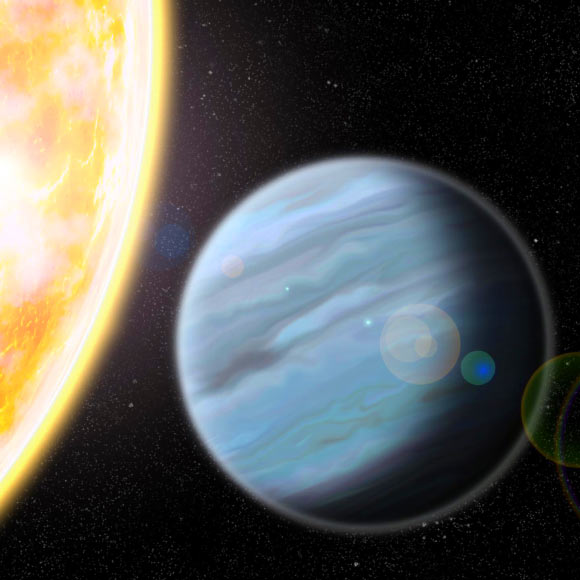A multinational team of astronomers led by Lehigh University researcher Joshua Pepper has discovered a ‘styrofoam’-density exoplanet orbiting the bright subgiant star KELT-11.

This is an artist’s rendering of the styrofoam-density exoplanet KELT-11b. Image credit: Walter Robinson, Lehigh University.
KELT-11b is an extreme version of a gas planet, like Solar System’s Jupiter or Saturn, but is orbiting very close to its host star in an orbit that lasts less than 5 days.
“This planet is highly inflated, so that while it’s only a fifth as massive as Jupiter, it is nearly 40% larger, making it about as dense as styrofoam,” said Dr. Pepper, an astronomer and assistant professor of physics at Lehigh University.
“We were very surprised by the amazingly low density of this planet. It’s extremely big for its mass.”
The planet’s host star, KELT-11, is extremely bright, allowing precise measurement of the planet’s atmosphere properties and making it ‘an excellent testbed for measuring the atmospheres of other planets.’
Also known as HD 93396, the host star has started using up its nuclear fuel and is evolving into a red giant, so the planet will be engulfed by the star and not survive the next hundred million years.
KELT-11b was first spotted by the Kilodegree Extremely Little Telescope (KELT) survey, and is described in a study published in the Astronomical Journal (arXiv.org preprint).
The planet is the third-lowest density exoplanet with a precisely measured mass and radius that has been discovered.
“KELT-11b is one of the most inflated planets known, with an exceptionally large atmospheric scale height (1,717 miles, or 2,763 km), and an associated size of the expected atmospheric transmission signal of 5.6%,” Dr. Pepper and co-authors said.
“These attributes make the KELT-11 system a valuable target for follow-up and atmospheric characterization, and it promises to become one of the benchmark systems for the study of inflated exoplanets.”
_____
Joshua Pepper et al. 2017. KELT-11b: A Highly Inflated Sub-Saturn Exoplanet Transiting the V = 8 Subgiant HD 93396. AJ 153, 215; doi: 10.3847/1538-3881/aa6572







